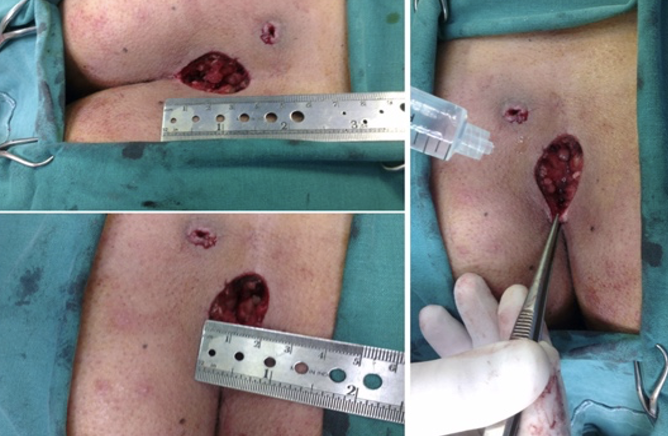Manuka Honey Versus Wet to Dry Dressing for Wound Closure Time After Open Pilonidal Sinus Surgery
DOI:
https://doi.org/10.38179/ijcr.v3i1.25Keywords:
Sacrococcygeal Pilonidal Disease, Open Wound, Manuka Honey, Wet to Dry DressingAbstract
Background: Sacrococcygeal pilonidal sinus disease is a very common chronic inflammation of the natal cleft that presents frequently as an abscess. Management requires the eradication of the sinus tract and postoperative wound care. Manuka honey (Medihoney) was used in acute and chronic wounds. In our study, we sought to investigate the clinical effectiveness of Manuka honey in decreasing wound healing time post excision.
Material and Methods: We describe patients’ characteristics using traditional descriptive statistics. We compared the study endpoint (wound closure time) in patients who received Medihoney versus those who did not by Kaplan-Meier analysis.
Results: A total of 119 patients underwent pilonidal cyst surgery between the years 2017 and 2018. The median time for healing in the Medihoney group was 40 days compared with 39 days in the control group. After adjusting for age, BMI, wound length, wound volume, smoking and operative time, the time to healing in the Medihoney group was significantly less compared to the group not receiving the treatment (Hazard Ratio 1.56, 95% Confidence interval 1.02- 2.49, p= 0.041).
Conclusion: Postoperative use of Manuka honey showed a significant decrease in wound healing time when compared to gauze fabric dressings. Further research would be beneficial to explore optimal treatment protocols for this dressing technique.
References
Horwood J, Hanratty D, Chandran P, Billings P. Primary closure or rhomboid excision and Limberg flap for the management of primary sacrococcygeal pilonidal disease? A meta-analysis of randomized controlled trials. Colorectal Dis. 2012;14(2):143-151. PMID: 20969718 https://doi.org/10.1111/j.1463-1318.2010.02473.x
McCallum IJ, King PM, Bruce J. Healing by primary closure versus open healing after surgery for pilonidal sinus: systematic review and meta-analysis. BMJ. 2008;336(7649):868-871. PMID: 18390914 https://doi.org/10.1136/bmj.39517.808160.BE
Milone M, Velotti N, Manigrasso M, Anoldo P, Milone F, De Palma GD. Long-term follow-up for pilonidal sinus surgery: A review of literature with metanalysis. Surgeon. 2018;16(5):315-320. PMID: 29699781. https://doi.org/10.1016/j.surge.2018.03.009
Doll D, Krueger CM, Schrank S, Dettmann H, Petersen S, Duesel W. Timeline of recurrence after primary and secondary pilonidal sinus surgery. Dis Colon Rectum. 2007;50(11):1928-1934. PMID: 17874268. http://dx.doi.org/10.1007/s10350-007-9031-4
Al-Khamis A, McCallum I, King PM, Bruce J. Healing by primary versus secondary intention after surgical treatment for pilonidal sinus. Cochrane Database Syst Rev. 2010;2010(1):CD006213. Published 2010 Jan 20. PMID: 20091589. https://doi.org/10.1002/14651858.CD006213.pub3
Thomas M, Hamdan M, Hailes S, Walker M. Manuka honey as an effective treatment for chronic pilonidal sinus wounds. J Wound Care. 2011;20(11):528-533. PMID: 22240847 https://doi.org/10.12968/jowc.2011.20.11.528
Subrahmanyam M. Topical application of honey in treatment of burns. Br J Surg. 1991;78(4):497-498. PMID: 2032114. https://doi.org/10.1002/bjs.1800780435
Al-Waili NS, Saloom KY. Effects of topical honey on post-operative wound infections due to gram positive and gram negative bacteria following caesarean sections and hysterectomies. Eur J Med Res. 1999;4(3):126-130. PMID: 10085281
Gethin G, Cowman S. Case series of use of Manuka honey in leg ulceration. Int Wound J. 2005;2(1):10-15. PMID: 16722850 https://doi.org/10.1111/j.1742-4801.2005.00078.x
Sare JL. Leg ulcer management with topical medical honey. Br J Community Nurs. 2008;13(9). PMID: 19024040 https://doi.org/10.12968/bjcn.2008.13.Sup4.30930
van der Weyden EA. Treatment of a venous leg ulcer with a honey alginate dressing. Br J Community Nurs. 2005;Suppl:S21-S27. PMID: 15944502 https://doi.org/10.12968/bjcn.2005.10.Sup2.18175
Hejase MJ, Simonin JE, Bihrle R, Coogan CL. Genital Fournier's gangrene: experience with 38 patients. Urology. 1996;47(5):734-739. PMID: 8650874 https://doi.org/10.1016/S0090-4295[96]80017-3
Lay-flurrie K. Honey in wound care: effects, clinical application and patient benefit. Br J Nurs. 2008;17(11):S30-S36. PMID: 18773594 https://doi.org/10.12968/bjon.2008.17.Sup5.29649
Sharp A. Beneficial effects of honey dressings in wound management. Nurs Stand. 2009;24(7):. PMID: 19927561 http://dx.doi.org/10.7748/ns.24.7.66.s54
Molan, P. Why honey is effective as a medicine: 2. The scientific explanation of its effects. Bee world. 2001;82(1). https://doi.org/10.1080/0005772X.2001.11099498
Mavric E, Wittmann S, Barth G, Henle T. Identification and quantification of methylglyoxal as the dominant antibacterial constituent of Manuka (Leptospermum scoparium) honeys from New Zealand. Mol Nutr Food Res. 2008;52(4):483-489. PMID: 18210383 https://doi.org/10.1002/mnfr.200700282
Aggad, H., & Guemour, D. Honey antibacterial activity. Med. Arom. Plants. 2014;3.http://dx.doi.org/10.4172/2167-0412.1000152
Boateng J, Diunase KN. Comparing the Antibacterial and Functional Properties of Cameroonian and Manuka Honeys for Potential Wound Healing-Have We Come Full Cycle in Dealing with Antibiotic Resistance?. Molecules. 2015;20(9):16068-16084. Published 2015 Sep 2. doi:10.3390/molecules200916068. PMID: 26364634 https://doi.org/10.3390/molecules200916068
STALEY CA. Colon and Rectal Surgery, 4th edition. Ann Surg. 2001;234(6):814.
Hull TL, Wu J. Pilonidal disease. Surg Clin North Am. 2002;82(6):1169-1185. PMID: 12516846. https://doi.org/10.1016/s0039-6109(02)00062-2
Lesalnieks I, Fürst A, Rentsch M, Jauch KW. Erhöhtes Rezidivrisiko nach primärem medianem Wundverschluss bei Patienten mit Pilonidalsinus [Primary midline closure after excision of a pilonidal sinus is associated with a high recurrence rate]. Chirurg. 2003;74(5):461-468. PMID: 12748795. https://doi.org/10.1007/s00104-003-0616-8
Bascom J, Bascom T. Failed pilonidal surgery: new paradigm and new operation leading to cures. Arch Surg. 2002;137(10):1146-1151. PMID: 12361421. https://doi.org/10.1001/archsurg.137.10.1146
Kronborg O, Christensen K, Zimmermann-Nielsen C. Chronic pilonidal disease: a randomized trial with a complete 3-year follow-up. Br J Surg. 1985;72(4):303-304. PMID: 3886069 https://doi.org/10.1002/bjs.1800720418
Bethell E. Why gauze dressings should not be the first choice to manage most acute surgical cavity wounds. J Wound Care. PMID: 12838602. 2003;12(6):237-239. https://doi.org/10.12968/jowc.2003.12.6.26503
Agren MS, Ostenfeld U, Kallehave F, et al. A randomized, double-blind, placebo-controlled multicenter trial evaluating topical zinc oxide for acute open wounds following pilonidal disease excision. Wound Repair Regen. 2006;14(5):526-535. PMID: 17014663 https://doi.org/10.1111/j.1743-6109.2006.00159.x
Viciano V, Castera JE, Medrano J, et al. Effect of hydrocolloid dressings on healing by second intention after excision of pilonidal sinus. Eur J Surg. 2000;166(3):229-232. PMID: 10755338 https://doi.org/10.1080/110241500750009339
Al-Waili N, Salom K, Al-Ghamdi AA. Honey for wound healing, ulcers, and burns; data supporting its use in clinical practice. ScientificWorldJournal. 2011;11:766-787. Published 2011 Apr 5. PMID: 21479349 https://doi.org/10.1100/tsw.2011.78

Published
How to Cite
Issue
Section
Copyright (c) 2022 International Journal of Clinical Research

This work is licensed under a Creative Commons Attribution 4.0 International License.







